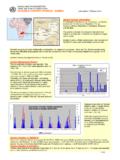Transcription of ENVIS Bulletin Vol 12 1 - gbpihedenvis.nic.in
1 E N V I S B u lletin : H im a la ya n E co logy 1 2 (1 ), 2 0 0 4 1 ISSN : 0971-7447 ENVIS Bulletin _____ HIMALAYAN ECOLOGY Volume 12, No. 1, 2004 Pant Institute of Himalayan Environment and Development (An autonomous Institute of Ministry of Environment and Forests, Government of India) E N V I S C en tre , G B P I H E D 2 About the Bulletin ENVIS Bulletin on Himalayan Ecology is a biannual non-priced publication of the ENVIS Centre that was established in the headquarters of the Pant Institute of Himalayan Environment and Development (GBPIHED) in 1992 with the financial support from the Ministry of Environment and Forests, Government of India, New Delhi.
2 The present volume of the ENVIS Bulletin is twelfth in a series of its biannual publication and contains papers on various aspects of horticulture , agriculture, medicinal plants and animal husbandry. The news and views offered in the papers in this publication are the views of the concerned authors. Therefore, they do not necessarily reflect the views of the editors, the ENVIS Centre or the Institute. The content of the Bulletin may be quoted or reproduced for non-commercial use provided the source is duly acknowledged. The contributions to the next issue of the Bulletin in a form of research paper, popular article, news item, technical report, etc., related to the aspects of Himalayan Ecology are always welcome.
3 However, the matter supplied by the individual/organization may be edited for length and clarity. Request for institutional subscription of the Bulletin may be sent to the Scientist-in-Charge of the ENVIS Centre. The comments/suggestions for further improvement of the Bulletin are welcome. Dr. Dhyani Executive Editor, ENVIS Bulletin , Pant Institute of Himalayan Environment and Development, Kosi-Katarmal, Almora 263 643, Uttaranchal, India Tel : 05962-241153(O)/241156(R)/9412092189(M) Fax : 05962-241153/241150 E-mail : Website : E N V I S B u lletin : H im a la ya n E co logy 1 2 (1 ), 2 0 0 4 3 Contents Research Papers DIVERSITY OF HORTICULTURAL CROPS IN NORTH EASTERN REGION Asati and Yadav ANALYSIS AND CHARACTERIZATION OF RICE ENVIRONMENT OF ARUNACHAL PRADESH Mishra, Bundela and Satapathy SACRED GROVES AS REPOSITORIES OF GENETIC DIVERSITY A CASE STUDY FROM KABI-LONGCHUK, NORTH SIKKIM Avasthe, Rai and Rai MILK PRODUCTION, MARKETING AND CONSUMPTION PATTERN AT PERI-URBAN DAIRY FARMS IN THE MOUNTAINS: A CASE FROM LOHAGHAT IN UTTARANCHAL Babita Bohra, Mahak Singh, Anil Kumar and Vir Singh INFLUENCE OF NPK AND SPACINGS ON THE GROWTH AND YIELD OF HERBAGE OF CALLICARPA MACROPHYLLA VAHL PRIYANGOO.
4 A LESS KNOWN MEDICINAL PLANT Sharma, Negi, Bhandari, Shukla and Pareek SEROPREVALENCE OF TOXOPLASMA ANTIBODIES IN DOMESTIC ANIMALS- AN INDICATOR OF TOXOPLASMA GONDII IN THE ENVIRONMENT AND HUMAN Jithendran Research Communication TRADITIONAL ANIMAL REARING PRACTICES IN MOUNTAINS OF HIMACHAL PRADESH Ram Singh and Bimal Misri Selected Abstracts Forthcoming Events News & Views Hindi Section t S o fofo /kr k l aj{ k. k esa /kk feZ d ouksa d k egR o% ,d ig y J hd j iarJ hd j iarJ hd j iarJ hd j iar E N V I S C en tre , G B P I H E D 4 DIVERSITY OF HORTICULTURAL CROPS IN NORTH EASTERN REGION Asati and Yadav Division of horticulture , ICAR Research Complex for NEH Region, Umroi Road, Umiam 793103, Meghalaya INTRODUCTION The North East region has its own unique combination of living species, habitats and ecosystems, which together make up its diversity rich resource.}
5 While speaking strictly about plant diversity, two regions of the country are termed as hot spots. These are Western Ghats and the North Eastern hill regions. In all living organisms the species is the single most useful unit to use in diversity assessment. Species richness and the relative abundance of different species is another criterion to measure the degree of diversity. The number of endemic species also reflects into account while assessing the richness of diversity. The North Eastern region of India comprising eight states namely Arunachal Pradesh, Assam, Manipur, Meghalaya, Mizoram, Nagaland, Tripura and Sikkim has vast physiographical variations, which have been represented in 6 agro climatic zones.
6 North East region is one of the richest reservoir of genetic variability and diversity of different crops various kinds of fruits (Table 1 & 2), different vegetables (Table 3), spices, ornamental plants and also medicinal & aromatic plants. The diversity for horticultural crops of this region has mainly been managed by local farmers, often women. Considerable diversity exists among the regional horticultural species including variation in plant type, morphological and physiological characteristics, reactions to diseases and pests, adaptability and distribution. Apart from the nutritional value, many regional horticultural crops are used for medicinal purposes, income generating and poverty alleviation programmes in the rural areas.
7 EXPLORATION AND DISTRIBUTION Fruits Citrus: Being the home of several citrus species, rich genetic diversity occurs in the region. Bhattacharya and Dutta (1956) described 17 citrus species, their 52 cultivars and a few probable natural hybrids from this region. In lemon alone, as many as 32 strains are available. The species C. limon, C. medica, C. jambhiri, C. ichangensis, C. latipes, C. macroptera, C. assamensis, C. indica and C. aurantium are considered indigenous to this region. The Indian wild orange C. indiaca is found in the Naga hills and Meghalaya. Banana and mango: Maximum genetic variability of Musa acuminata and M. balbisiana occurs in NE India. M. flaviflora is localized to Manipur and Meghalaya.
8 There are other species found in Sikkim and Khasi Hills, which need systematic collection and conservation. Some native Mangifera spp. are found in Tripura, Manipur, Mizoram and South Assam. Wild form of M. indica and its allied species M. sylvetica occur in Arunachal Pradesh, M. khasiana and M. pentandra in Assam. Temperate fruits: Rich diversity occurs in Pyrus, Rubus, Ribes and Prunus. The Shillong plateau of Khasi hills in Meghalaya has many Prunus species such as P. napalensis, P. undulata and P. cerasoides. Pyrus pyrifolia var. cubha makai (P. serotina Red) is grown semi commercially in Meghalaya, Manipur and other places. Wild kiwi (Actinidia callosa and A. stragosa) is found growing in the natural forests of Arunachal Pradesh and Sikkim.
9 E N V I S B u lletin : H im a la ya n E co logy 1 2 (1 ), 2 0 0 4 5 Tropical and sub tropical fruits: A large number of other tropical and subtropical fruits belonging to the genera Garcinia, Artocarpus, Phyllanthus, Annona, Averrhoa, Persia, Aegle, Passiflora, etc., are found growing wild in the region. One of the indigenous fruits that requires attention is jackfruit, which grows abundantly in Tripura, Assam and Meghalaya with a large number of cultivars. Under utilized fruits: Of the 300 edible plant species found in the NE region, some of them are really worth consuming by various ethnic groups of tribals. Two species of Elaegnus, viz E. latifolia and E. pyriformis are known to be grown in NE region (Pandey, 2002).
10 It is quite common in Sibsagar (Dikho valley), Naga hills, Khasi and Jaintia hills. Docynia indica and D. hookeriana are commonly found in the region. Pyrus pashia is a medium sized deciduous fruit tree also found in NE region. Table 1. Diversity of major crops in North-East India. Crops Estimated diversities Diversities collected till 2000 Taros 300 272 Yams 230 200 Citrus 17 spp.+52 vars. 80 Banana 16 species 120 Orchids 700 species 15 Source: Hore (2001) Table 2. List of major fruit diversities in North East India. Common name Species No of cultivars in the region No. of wild relatives (approx) Distribution Tropical Mango Mangifera indica L. 25 2 Tropical areas of Assam, Meghalaya, Mizoram, Tripura Ber Zizyphus mauritiana Lamk 8 3 Plains and Hills upto 500m Pineapple Ananas comosus L.





